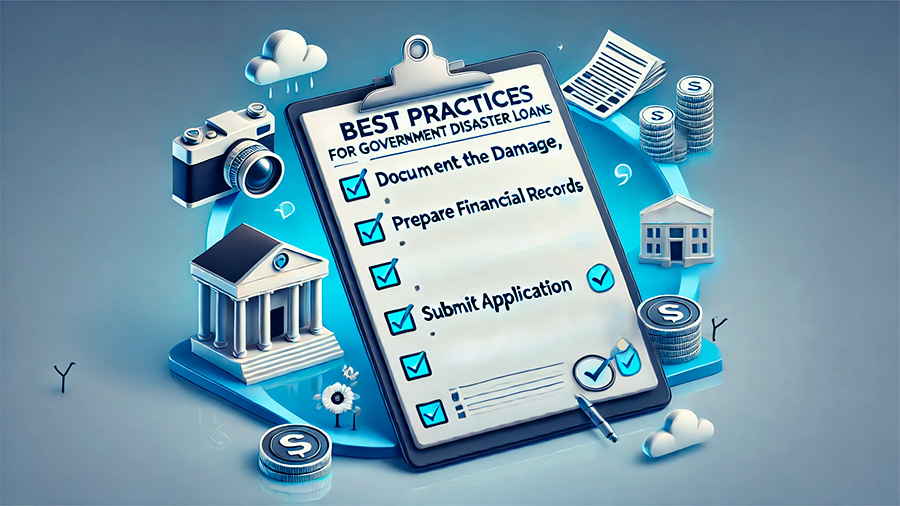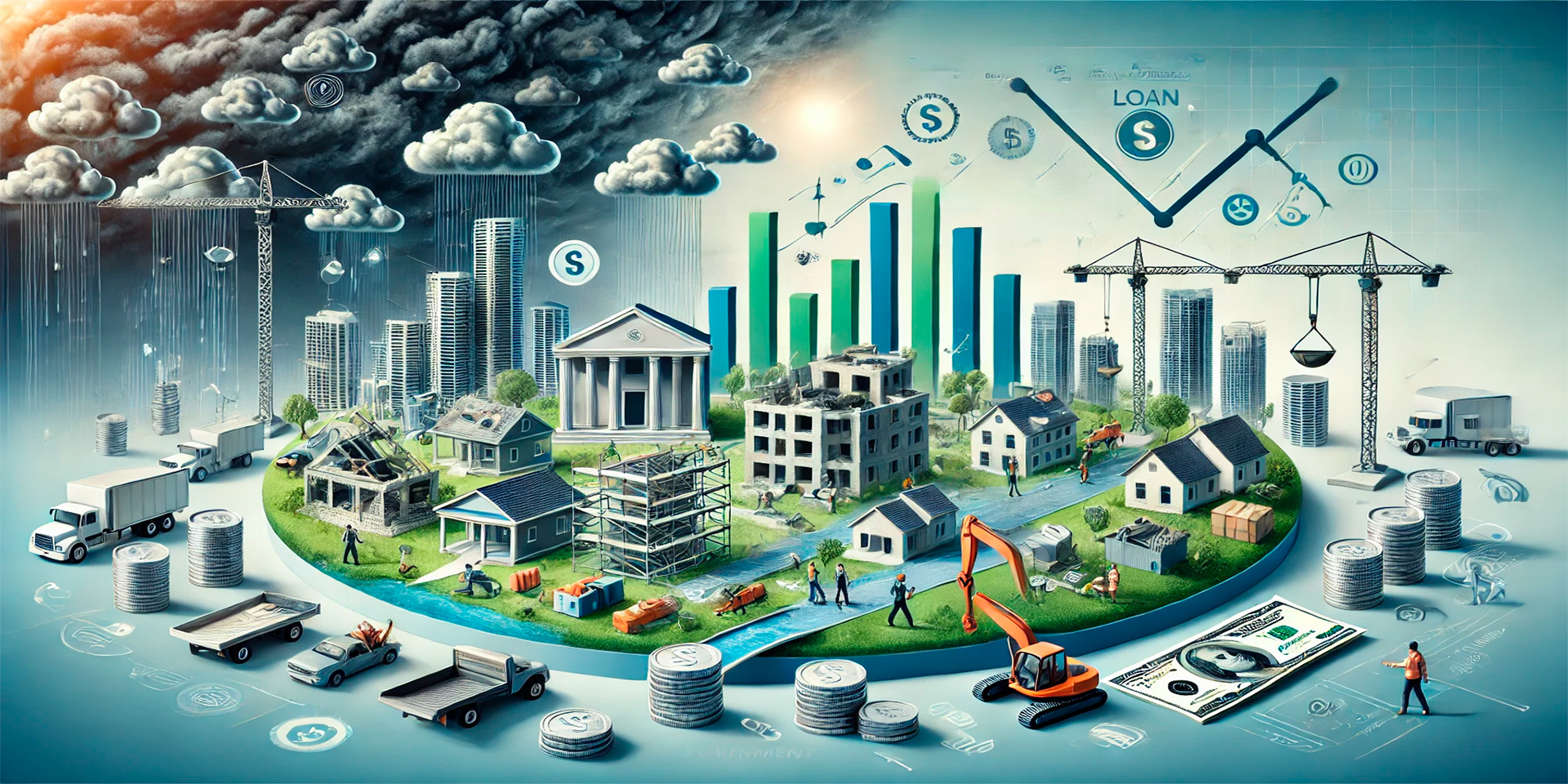Natural disasters such as hurricanes, earthquakes, floods, and wildfires can have devastating effects on communities, destroying homes, businesses, and infrastructure. While immediate disaster relief efforts are crucial, long-term recovery often requires significant financial support. Government-backed loans play a vital role in helping individuals, businesses, and local governments rebuild after natural disasters. This article explores how these loans provide essential funds for recovery and rebuilding, ensuring that communities can return to stability and growth after weather-related crises.
Understanding Government-Backed Loans for Disaster Recovery
Government-backed loans are designed to assist individuals and businesses in the aftermath of a natural disaster. These loans offer low-interest rates and extended repayment terms, making it easier for recipients to recover financially. The U.S. government, through agencies such as the Small Business Administration (SBA) and the Federal Emergency Management Agency (FEMA), offers several types of loans that serve different purposes in the recovery process.
1. Types of Government Loans for Disaster Recovery
There are several government loan programs available for those impacted by natural disasters, each catering to different recovery needs. These loans can help repair or replace damaged property, provide working capital for businesses, and assist with the rebuilding of public infrastructure.
Key government loans for disaster recovery:
- Small Business Administration (SBA) Disaster Loans: These loans help businesses recover by providing working capital and funding for property repairs, equipment replacement, and inventory replenishment. SBA disaster loans are available to small businesses, homeowners, and renters.
- FEMA Disaster Assistance Loans: FEMA provides low-interest loans to homeowners and renters whose property has been damaged or destroyed by a natural disaster. These loans help individuals repair or replace homes, furnishings, and other essential personal property.
- Economic Injury Disaster Loans (EIDL): For businesses experiencing a downturn in revenue due to a disaster, EIDLs provide funds to cover operating expenses, such as payroll, utilities, and rent, during the recovery period.
- Public Assistance Loans: These loans are available to state and local governments to help rebuild critical public infrastructure, including roads, bridges, and emergency services, which are essential for community recovery.
2. How Government Loans Help Individuals
For individuals affected by natural disasters, government loans are an important tool for rebuilding homes, replacing personal property, and covering temporary living expenses. These loans provide the financial means to restore homes and livelihoods, allowing families to return to normalcy after a disaster.
How government loans assist individuals after a disaster:
- Home repairs: Government loans can help homeowners repair or rebuild their homes that have been damaged or destroyed, including replacing essential utilities like electricity, water, and heating systems.
- Personal property replacement: For renters and homeowners alike, loans are available to replace furniture, appliances, and other essential items that were lost during the disaster.
- Temporary housing assistance: In some cases, FEMA loans can help individuals cover the costs of temporary housing if their homes are uninhabitable.
3. How Government Loans Help Businesses
For businesses, the economic fallout from a natural disaster can be severe. From inventory loss to supply chain disruptions, the financial strain can leave businesses unable to recover without assistance. Government-backed loans are critical for getting businesses back on their feet, helping them repair physical assets and ensure that operations can resume as quickly as possible.
How government loans support business recovery:
- Working capital: SBA Economic Injury Disaster Loans (EIDLs) provide businesses with the necessary funds to cover operational costs during periods when revenue is low due to disaster-related disruptions.
- Property damage repairs: SBA Physical Disaster Loans help businesses repair or replace damaged buildings, machinery, and equipment that are critical to their operations.
- Inventory replacement: Many businesses rely on inventory to operate. SBA loans can help replace lost or damaged inventory, ensuring that businesses can continue serving customers.
- Hiring and retaining employees: Government loans may also assist businesses in retaining or rehiring employees during the recovery process, preventing layoffs and helping maintain workforce stability.

Why Government-Backed Loans Are Essential for Disaster Recovery
After a natural disaster, the need for immediate relief is paramount. However, the recovery process often extends over months or even years, requiring substantial financial resources. Government-backed loans are crucial in providing long-term recovery solutions, ensuring that affected communities can rebuild their economies and infrastructure while minimizing the financial burden on individuals and businesses.
1. Low-Interest Rates and Favorable Terms
Government loans typically offer much lower interest rates than private loans, making them an attractive option for those looking to recover from a disaster. These loans are also often more flexible in terms of repayment, with long repayment periods and the option for deferment in some cases. This allows borrowers to rebuild without the immediate pressure of high monthly payments.
Benefits of government loans for disaster recovery:
- Low-interest rates: Government-backed loans typically feature interest rates that are significantly lower than those of conventional loans, making them more affordable for borrowers.
- Long repayment periods: Most government loans offer extended repayment terms, with some lasting up to 30 years, allowing borrowers to pay back loans over a longer period with lower monthly payments.
- Deferred payments: Some loans allow for deferred payments during the rebuilding phase, providing immediate financial relief to those still recovering from the disaster.
2. Accessibility to a Wide Range of Individuals and Businesses
One of the most important aspects of government disaster loans is their accessibility. These loans are available to individuals, small businesses, and governments alike, with minimal eligibility requirements. This ensures that even those with limited access to traditional financing options can still secure the funds needed for recovery.
Why government loans are accessible to all:
- Flexible eligibility criteria: Government loans are typically offered with broad eligibility criteria, ensuring that anyone directly impacted by the disaster is able to apply.
- Minimal credit requirements: Many government-backed loans do not require a credit check or require a minimal credit score, which can be helpful for those affected by financial instability during the recovery phase.
- Support for diverse needs: Government loans are designed to meet the varied needs of individuals, businesses, and public infrastructure, providing comprehensive support for all areas of recovery.

Best Practices for Applying for Government Disaster Loans
While government loans provide valuable assistance, securing them requires following specific steps and meeting certain requirements. Here are some best practices for applying for disaster recovery loans.
1. Gather Required Documentation
Whether applying for an individual loan or a business loan, having all necessary documentation ready is critical for a smooth application process. This may include proof of identity, proof of residence, income statements, and damage assessments.
Documents to prepare:
- Personal identification: Provide a government-issued ID, proof of residency, and any other identification documents required.
- Financial information: For businesses, this may include income statements, tax returns, and other financial records that demonstrate the impact of the disaster.
- Damage assessment: Insurance claims, damage reports, and photographs can be essential for proving the extent of the disaster’s impact and qualifying for a loan.
2. Apply Early
Disaster recovery loans are typically offered on a first-come, first-served basis. Applying as early as possible increases your chances of receiving the necessary funds to begin rebuilding. Be sure to check the application deadlines and submit all required documents on time to avoid delays in processing.
3. Understand Loan Terms
Before accepting any loan offer, carefully review the terms, including the interest rate, repayment schedule, and any potential fees. It is essential to ensure that the loan terms align with your ability to repay and that the loan will support your long-term recovery efforts.
Conclusion
Government-backed loans are a critical resource for individuals, businesses, and local governments in the aftermath of natural disasters. By providing affordable financial support, these loans help communities rebuild, restore infrastructure, and recover economically. With accessible terms, low-interest rates, and flexible repayment options, government loans play an essential role in stabilizing affected areas and paving the way for long-term recovery. By understanding the application process and following best practices, individuals and businesses can leverage these loans to bounce back stronger after disaster strikes.

